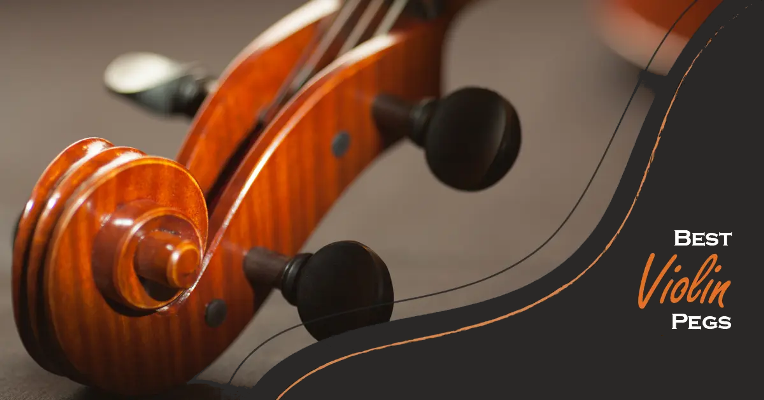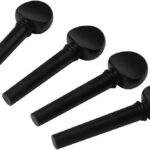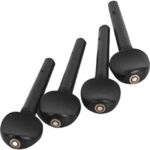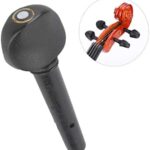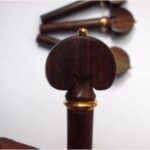It’s really easy for us to get obsessive about violin stuff, but sometimes the small parts are what make all the difference. Some people forget about tuning pegs, or don’t know anything good ones from bad. Violin pegs are important – they keep the strings at a good tension so you can play without worrying about tuning.
Pegs are usually pre-installed in violins, an instrument you usually only think about when buying or renting one. The quality of pegs has a bearing on both sound and playability, such as intonation and sustain.
- Tuning pegs are made from all sorts of materials, including plastic and wood.
- They come in a variety of sizes to match the size of instrument they’re being fitted into.
- Each one of our guitars is made by hand in Colombia and sounds different from the last.
- Some peg boards have an ornamental design, while others are plain.
To get a sense of how different pegs change the sound of the violin, let’s look at what they’re made from.
Top Violin Pegs Review
Violin pegs are pretty important for ensuring all your strings are in tune. They can break, however, if they’re not installed correctly or if your strings are too loose. Another factor that contributes to slipping is a significant change in humidity. Your strings need to be tightened/loosened so they’ll sound the way you want them to. This is done by tuning pegs, also called tuning pigs.
One of the weaknesses in most violins is that they’re not provided enough stability with their current tuning pegs. Thankfully, many companies manufacture new tuning pegs if you require them! Here are our picks on the best violin tuning pegs currently being offered.
1. Knilling 4/4 size Perfection Planetary Geared Violin Peg Set with Synthetic Head
Knilling’s tuning pegs are a versatile option. They might look similar to wood, but resist corrosion and provide greater tuning stability. As well as the visual appeal, these pegs also offer the same quality of tuning as more traditional versions.
Additionally, their internal gear design makes these pegs incredibly easy to tune, which is great for new players and older players who may lack the hand strength to tune their instrument with wooden pegs. Their 4:1 gear reduction also means that fine tuning the tailpiece is not required.
Installing these pegs is easy even if you’re not a professional, but it’s recommended to get someone with experience. After that, you can easily use them to adjust the pitch of your instrument. These pegs are not the cheapest on the market, but they will last you years and allow you to tune your instrument more easily.
2. Perfection Planetary Violin Pegs Set For Violin
These violin pegs by Perfection make tuning pretty easy and they help produce a better quality of sound. They are installed with glue, which is easier and more reliable than the process of installing a fine tuner.
When installing the pegs yourself, try to be careful because the instructions are easy to misinterpret. A professional would likely do a better job and it’ll save you time. Once installed, our mats are securely stuck and slip resistant. They can also be swapped out in just a matter of minutes if the situation changes. These pegs have a little higher price but they’re worth it and I really don’t think you’ll require any other violin pegs.
3. WITTNER ZW 917-Fine-Tune-Peg for Violin
Wittner violin pegs are a popular alternative to wooden pegs, and for good reason! They make tuning much easier, which can be a total pain sometimes. The material they are made of helps make the whole process much easier than with traditional wooden pegs.
This brand makes their pegs in Germany, which means you’ll never have to worry about strings becoming loose if you use them with these. Okay, we know that you’re really interested in these pegs and want to make sure they work great. To do this, the best thing you can do is install them properly. These German pegs are not the cheapest on the list, but they are worth it with their use of high quality materials.
4. Anton Breton VP-140 Violin Tuning Pegs – Set of 4 – Ebony – 1/2
At Anton Breton we always bring you the best pegs at a reasonable price. This set of violin pegs is made with quality materials and can be yours now for a great price.
There are many sizes of ebony pegs available, so never worry about these not fitting your instrument. They come with oversized shafts to ensure they will fit your guitar perfectly. They are hand-crafted from ebony and vary in size. These pegs have a feature that you’ll need to get professionally installed on your board. So if you’re looking for an affordable alternative, this isn’t the item for you.
The combination of their realistic look and durability makes them a great choice for people looking for affordable, quality violin pegs.
5. Docooler 4/4 Size Violin Fiddle Tuning Peg 4pcs Set
If you’re looking for a set of tuning pegs for your violin that won’t break the bank, these are a solid option. They’re prefitted and may need to be adjusted, but the price is on point.
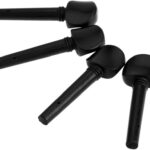
They come in a variety of sizes to fit any size violin and we think you’ll be happy with them. They’re fairly cheap so it won’t hurt your wallet if you decide to go with these. You’ll get some good tuning pegs for the instrument as well!
6. 8Pcs Yootones 4/4 Wooden Violin Tuning Tuner Pegs
These Yootones violin pegs are made from smooth wood that has been polished. They’re heavy-duty, high-quality, and will last a long time. This set includes 8 pegs.
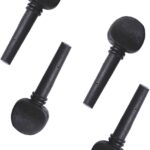
7. Drfeify Violin Tuning Pegs
A product of high quality ebony, this is a sturdy and durable material. You know it will last for a long time! Violin pegs are often used to replace old or broken ones. They offer a solid grip, which makes them perfect if you’re clumsy – not to mention they look good with any type of violin.
We process the fabric by hand and it makes a wonderful difference in texture. The type of fabric, pattern, and basic design are marvelous. The color held up great due to the careful manufacturing process. Every excellent handcrafted detail is easy to see making this into a lot of valuable clothing.
You can get four violin pegs in a bundle for easy use. They go on pretty easily, but if you need some adjustment to fit, that should work too!
8. Bnineteenteam 4 Pcs Ebony Violin Pegs
The violin pegs are made from high-quality ebony wood so they have a clean surface that doesn’t break easily. The wood is sturdy for prolonged usage and the main feature is that it helps tune the strings. Pure manual handmade, wonderful treatment with good texture, ornamental shell dot. Light-weight and portable, simple to set in and use.
An ebony wood, which is durable and developed to use, it has a beautiful pattern and a basic outline, it’s elegantly refined and will moderately last for quite a while. Here’s a nice piece of equipment for violin players. It’s really important for good or especially high-quality violins. It can replace rusty, damaged, old string shafts.
If you need new tuning pegs, it’s really nice to be able to find a set that’s affordable and can handle any broken pegs you have.
9. Rosewood Heart Shaped Pegs w, Boxwood Collar & Pin – 4/4 Violin
Finally, these rosewood pegs from Alexi Strings are sure to please any violin player. They’re handcrafted and come with a lifetime guarantee.
These pegs are pretty inexpensive and will last a long time. Made with high-quality materials, it’s hard to beat the price. These heart shaped pegs are a perfect accompaniment to your violin. They can be tuned easily which will give the instrument a crisp sound.
Wood or Composite
When you’ve found the right size, choosing your pegs is more of a personal preference. The luthier can help with that and they should match not only the type of violin but also a type of player. PEGs come in two different types: Real wood ones and artificial composite ones.
The most common type of violin peg is a mix of natural wood and synthetic resin. Because the synthetic element’s the one you see, some people might say its artificial materials take away from the instrument’s natural beauty.
They’re also a bit more finicky in terms of tuning. Wooden pegs can often be tweaked, but if your tuning box is designed to plug in synthetic pegs, you can’t really adjust the tuners.
Most luthiers tend to be a bit more traditional and say that you would want to select violin pegs made out of ebony, boxwood, or rosewood.
3 types of wood are used to make violin pegs and they all have different effects on the sound of your strings. Which one you use can depend on the type of sound that you want.
Wooden pegs are usually made from Ebony, Rosewood, or Boxwood:
- Ebony is the hardest of the 3 woods and stays blackest. It’s also one of the most durable.
- Rosewood is painted with its own resin, so it’s good at holding on to the peg. It’s less hardy than ebony and often comes in light brown shades.
- Boxwood is a general name for many of the newer woods used by modern violin makers. The quality range of these is pretty wide and many are lighter than the other two types.
Beginner violin students don’t need to focus on the type of pegs they use as long as it is a wooden peg. A lot of beginner violins are tuned using fine tuners and don’t need to worry about the pegs themselves.
One of the most important parts of a violin is the pegs. It’s always important to have a good quality set, but if you’re serious about playing then you’ll want to invest in an even better system.
Not all violin peg sets come with pre drilled holes for the strings to go through, so make sure to double check before you purchase. If they don’t have them, you’ll need to go to your local violin shop and have the holes drilled in there. This is a pretty simple process. If you don’t have someone around to do this, then make sure you buy pre-drilled pegs for your violin.
When it comes to your violin, there’s a lot that goes into the choice of pegs. Almost as much as there is making your hand fit right or in choosing the right sort of effects for a studio. That being said, make sure you try out different models at local violin shops and see what each feel like to play with.
How are These Pegs Different From Each other?
Pegs only slightly vary from one another depending on the fabric they had been made out of. Artificial plastic ones are made of plastic, while wooden pegs are made of different types of wood.
So, there are several types of pegs – but they all have the same function regardless. It’s really just a matter of what type performs better than the others, when available.
That’s why many violinists prefer to use wooden pegs.
Guide on How to Fit Violin Pegs
Now that you understand the types of pegs, you may need to know how to put them on your instrument. You do not need to purchase new pegs – it’s possible to substitute the original ones that came with the instrument.
Pegs won’t work correctly unless they’re put in the tapered hole. Before you start feeding the peg into the hole:
- Take away the pegs of the fiddle and the strings will hang slack.
- Place the reamer on the string’s holes and gently turn it. Once you can see fresh wood on the wall, go to the next hole.
- Take a peg and put it in the right box as you shape it.
- Experts can use lubricants to slide the pegs into place if they need to. Violinists will also use a rasp which is a tool that you could use to soften up the holes on your violin. Shapers let the pegs slide in easily.
- You can measure the distance between the pegs by putting them in all the way. This will show you how much space there is between them, making sure they are in at 3/8 of an inch. If they are put too close together, it will also make it impossible to tuck away your violin.
Conclusion
Guitarists love different types of guitar picks for a whole host of reasons. When choosing, try not to fuss over minute details because different brands and materials will be similar.
The pegs on our strings were cut from different types of wood and metal. So, if you want to find a replacement at any point, we’ve gathered the best options from both traditional wooden material and more modern metal peg types.
If you’re looking for new guitar pegs, we have a great selection at the shop. If you’re trying to stick with traditional stuff, go for brands like Anton Breton or Alexi.
FAQ for Best Violin Pegs
What is a violin peg?
A violin peg is a small, metal device that attaches to the end of the fingerboard (the top of the violin) and holds the strings in place. They are often made from ebony, boxwood, or other hardwoods.
The pegs are traditionally tapered from top to bottom with a hole at one end for tuning with an allen wrench or screwdriver and a slot at the top for adjusting string tension. The pegs are turned to tighten or loosen the tension of each string, which in turn changes the pitch.
What types of violin pegs are there?
It remains a bit of a mystery how the violin pegs were invented and who invented them. But there are two types of violin pegs: a flat peg, which is the most common type, and a round peg. A flat pin has a flat surface at one end that fits under the string, while a round pin has a round surface that fits over the string.
What are the materials that make up a good violin peg?
Pegs are the small wooden pieces that help hold the strings in place on a violin. They are made of wood and have a metal spike at the top that is used to secure them into the instrument.
The material that makes up a good peg is hardwood, such as beech, maple or cherry. The peg should be thick enough to keep it from bending under pressure from the strings, but not so thick that it is difficult to carve out a hole for the string to go through. Pegs can also be made of carbon fiber composite or plastic with metal spikes attached.
How do I use the pegs to tune the violin?
Pegs are used to tune strings on a violin. They are also known as adjusting screws, and they tighten or loosen the string to adjust the pitch. These tuning pegs are made of metal and have an L-shaped end that attaches to the guitar head. You can use them by placing them on both sides of the string and then turning in opposite directions until you hear the melodic note of your instrument.
What are the qualities of the best violin pegs?
The best violin pegs should be made from durable materials like brass or steel to hold up against wear and tear over time. They should also have a smooth surface so they don’t damage your instrument’s fingerboard.
What should I look for when buying violin pegs?
A violin peg is one of the most important parts of your instrument. It is what holds the strings in place and makes sure that they don’t go out of tune. A good peg will last for a long time, but there are many different kinds of pegs on the market.
Some people prefer metal pegs because they have a more stable tone than wooden ones. Some prefer wooden pegs because they are less likely to slip and can be tuned more precisely. You should also consider the size and shape of your violin’s bridge when looking for new pegs – it will make all the difference!
How much do violin pegs cost?
Most violin pegs are made of wood, bone or plastic. The cost of violin pegs can be as low as $2 or as high as $50.
